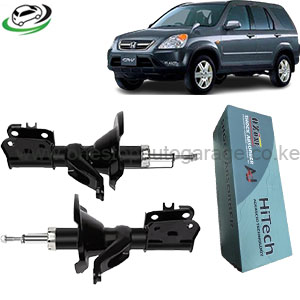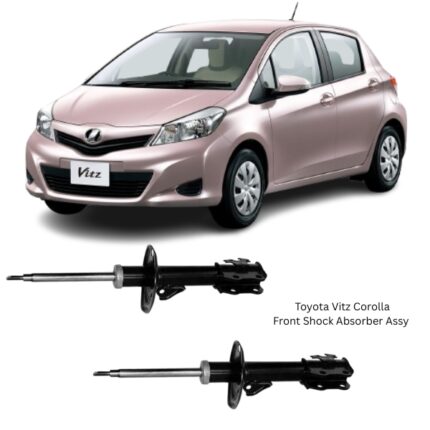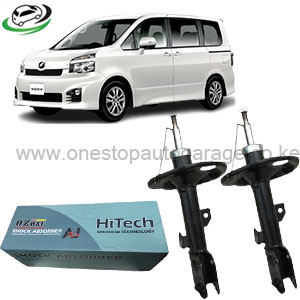Get Toyota Noah/Voxy ZRR70 Front Shock Absorber Assy 335068 / 335069 in Kenya
The Front Shock Absorber Assembly is a vital suspension component engineered to manage and dampen the kinetic energy generated from road irregularities, braking, acceleration, and cornering. Positioned between the vehicle’s chassis and front wheels, this component ensures ride comfort, directional stability, and optimal tire contact with the road surface.
Designed with precision, the front shock absorber assembly works in tandem with other suspension elements like control arms, springs, and stabilizer links to deliver a smooth, safe driving experience across diverse terrains. It serves both a comfort-enhancing and safety-critical function, making it a key part of any vehicle’s handling system.
Core Functionality
The front shock absorber’s main function is to control and dissipate the energy transmitted from the road surface. It achieves this by resisting compression and rebound movement of the suspension system through hydraulic damping. The assembly effectively reduces oscillation caused by uneven surfaces, braking force, and cornering inertia.
Key roles include:
-
Damping Road Impacts: Absorbs shocks from potholes, speed bumps, and rough terrain.
-
Stabilizing Suspension Movement: Controls spring oscillation, preventing excessive bounce.
-
Enhancing Steering Precision: Helps maintain tire-road contact, which is crucial for steering response.
-
Improving Braking Efficiency: Minimizes weight transfer during deceleration, reducing stopping distances.
-
Enhancing Ride Comfort: Smooths out the ride by absorbing harsh impacts and road vibrations.
Construction and Design
The Front Shock Absorber Assembly consists of multiple precision-engineered components housed within a robust, sealed casing designed for long-term performance under high stress.
Key Components:
-
Outer Tube / Body:
Constructed from high-tensile steel or aluminum alloy, this cylindrical housing encloses the internal components and provides strength and durability. -
Piston Rod:
Hardened and chrome-plated for corrosion resistance and smooth operation. The rod transmits motion to the piston inside the cylinder. -
Piston & Valve System:
A multi-valve design regulates fluid flow during compression and rebound, delivering precise damping response. -
Hydraulic Oil:
A specialized oil that passes through the piston valves to absorb kinetic energy and dissipate heat during compression and rebound cycles. -
Sealing System:
High-pressure seals prevent oil leakage and contamination, ensuring consistent performance. -
Dust Boot / Cover:
Protects the piston rod and seals from debris, dust, and moisture. -
Mounting Points:
Engineered to match specific suspension geometries and facilitate direct bolt-on installation. Typically includes upper mount and lower eye or bracket.
Depending on the design, shock absorber assemblies may be twin-tube or mono-tube in configuration. Twin-tube shocks offer comfort and cost-efficiency, while mono-tube designs provide higher performance and better heat dissipation.
Performance Characteristics
-
Compression Damping: Controls the energy absorbed when the wheel moves upward over a bump.
-
Rebound Damping: Controls the return motion as the suspension springs back after compression.
-
Linear or Progressive Response: Offers consistent or adaptive damping depending on valve design and tuning.
-
Temperature Stability: Maintains performance in varying weather conditions and operating temperatures.
-
Noise and Vibration Isolation: Reduces cabin vibration and road noise.
Front shock absorbers are tuned for balance—ensuring comfort without sacrificing handling dynamics. Their design accounts for vehicle weight, suspension geometry, and dynamic load transfer.
Signs of Wear or Failure
Shock absorbers are wear-and-tear components that deteriorate over time. When compromised, they can reduce comfort and compromise safety.
Common indicators include:
-
Excessive Bouncing: Vehicle continues to bounce after hitting a bump.
-
Nose Diving During Braking: Front end dips sharply under braking force.
-
Poor Steering Response: Increased body roll or instability during turns.
-
Uneven Tire Wear: Patchy tire wear due to poor wheel control.
-
Oil Leakage: Visible fluid on the outer housing or rod area.
-
Clunking or Rattling Noise: Loose or broken internal components.
-
Longer Braking Distance: Reduced road contact from bouncing or skidding tires.
Regular inspection and timely replacement are essential for maintaining vehicle performance and safety.
Installation Guidelines
Proper installation of the front shock absorber assembly is crucial for safety, handling, and part longevity. While replacement is typically straightforward, professional handling is recommended to ensure alignment and torque specifications are met.
General Installation Process:
-
Raise and Secure the Vehicle
Use a hydraulic jack and jack stands to safely lift and stabilize the front end. -
Remove the Wheel
Gain clear access to the suspension assembly. -
Unbolt the Shock Absorber
Disconnect the upper mount and lower bolt(s) securing the shock to the control arm or steering knuckle. -
Remove Old Shock Assembly
Compress and extract carefully without damaging adjacent components. -
Install New Assembly
Align the new shock into place, ensuring mount bushings and washers are properly positioned. -
Torque to Specification
Use a torque wrench to tighten all fasteners to manufacturer-recommended values. -
Test Vehicle
Reinstall the wheel, lower the vehicle, and perform a test drive to ensure proper damping and stability. -
Wheel Alignment (Optional but Recommended)
For strut-integrated shocks or major suspension work, a realignment may be necessary.
Maintenance and Longevity
While shock absorbers are largely maintenance-free, regular inspections during oil service or tire rotation can help detect early signs of wear. Keeping the assembly free from mud buildup, rust, and physical damage helps extend its lifespan.
-
Recommended Replacement Interval: Typically every 70,000 – 100,000 km depending on terrain and driving habits.
-
Inspect During: Brake service, tire replacement, and during unusual ride behavior.
Advantages of Replacing Worn Shocks
Replacing worn front shock absorber assemblies yields several performance and safety improvements:
-
Restores original ride comfort and handling
-
Improves braking effectiveness
-
Enhances steering stability and control
-
Reduces tire wear and suspension strain
-
Prevents damage to other suspension components
Upgrading to high-quality shock absorbers also increases vehicle safety in wet or uneven conditions by improving tire-to-road contact.
Follow us on Facebook for more parts.



